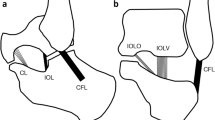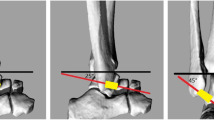Abstract
Clinical diagnosis of lateral collateral ligamentous injury caused by ankle sprains depends primarily on clinical signs, and X-ray and CT images. None of these, however, provide direct or accurate information about ligamentous injury. MRI has long been testified as a useful tool in the demonstration of ligaments due to its good resolution of soft tissues. We confirmed the appearance of the lateral collateral ligaments of the ankle joints on MR images by comparing MR images with CT images of the ligaments enhanced by coating with contrast medium after dissection of six cadaver feet. Compare study of MR images reveals no difference in the natural position and the dorsal position (P > 0.05), whereas, taken into the consideration the long hour of MRI examination, the natural position is regarded as the optimal position for MRI performance. Measured on transverse MR images, lateral ligaments of acutely injured ankles were significantly thicker than those of normal ankles (P < 0.01). According to the MR images of normal and injured ankles, the lateral collateral ligaments injuries were classified as type I and type II. Osteal contusion, cartilaginous injury, musculotendinous injury, tenosynovitis, and peritenosynovitis were also observed by MRI in type I and type II acute lateral collateral ligament injury. All these complications have higher incidence in type II than in type I injury (P < 0.05). Thus, by comparing with the CT images and the anatomy we confirmed the normal appearance of the lateral collateral ligaments on MR images and figured out that the natural position is the optimal position for MRI performance. The thickness of the ligaments and incidence of the complications could be regarded as useful cue for the assistant in clinical diagnosis of the lateral collateral ligament injury.




Similar content being viewed by others
References
Antonio GE, Griffith JF, Yeung DK (2004) Small-field-of-view MRI of the knee and ankle. Am J Roentgenol 183(1):24–28
Beltran J, Munchow AM, Khabiri H, Magee DG, McGhee RB, Grossman SB (1990) Ligaments of the lateral aspect of the ankle and sinus tarsi: an MR imaging study. Radiol 177(2):455–458
Breitenseher MJ (2007) Injury of the ankle joint ligaments. Radiol 47(3):216–223
Brown KW, Morrison WB, Schweitzer ME, Parellada JA, Nothnagel H (2004) MRI findings associated with distal tibiofibular syndesmosis injury. Am J Roentgenol 182(1):131–136
Bureau NJ, Cardinal E, Hobden R, Aubin B (2000) Posterior ankle impingement syndrome: MR imaging findings in seven patients. Radiol 215(2):497–503
Cheung Y, Rosenberg ZS (2001) MR imaging of ligamentous abnormalities of the ankle and foot. Magn Reson Imaging Clin N Am 9(3):507–531
De Smet AA, Graf BK (1994) Meniscal tears missed on MR imaging: relationship to meniscal tear patterns and anterior cruciate ligament tears. Am J Roentgenol 162(4):905–911
Dong WJ, Ma ZL, Yang YX, Yang GF, Liu GQ, Gong HL, Feng GF, Zhang FC (2004) A study on the sectional and imaging anatomy of the human ankle joints. Chin J Clin Anat 22(1):63–66
Farooki S, Yao L, Seeger LL (1998) Anterolateral impingement of the ankle: effectiveness of MR imaging. Radiol 207(2):357–360
Flick AB, Gould N (1985) Osteochondritis dissecans of the talus (transchondral fractures of the talus): review of the literature and new surgical approach for medial dome lesions. Foot Ankle 5(4):165–185
Grasel RP, Schweitzer ME, Kovalovich AM, Karasick D, Wapner K, Hecht P, Wander D (1999) MR imaging of plantar fasciitis: edema, tears, and occult marrow abnormalities correlated with outcome. Am J Roentgenol 173(3):699–701
Hardy CJ, Katzberg RW, Frey RL, Szumowski J, Totterman S, Mueller OM (1988) Switched surface coil system for bilateral MR imaging. Radiol 167(3):835–838
Hillier JC, Peace K, Hulme A, Healy JC (2004) Pictorial review: MRI features of foot and ankle injuries in ballet dancers. Br J Radiol 77(918):532–537
Kneeland JB, Hyde JS (1989) High-resolution MR imaging with local coils. Radiol 171(1):1–7
Mabit C, Boncoeur-Martel MP, Chaudruc JM, Valleix D, Descottes B, Caix M (1997) Anatomic and MRI study of the subtalar ligamentous support. Surg Radiol Anat 19(2):111–117
Masala S, Fiori R, Marinetti A, Uccioli L, Giurato L, Simonetti G (2003) Imaging the ankle and foot and using magnetic resonance imaging. Int J Low Extrem Wounds 2(4):217–232
Muhle C, Frank LR, Rand T, Yeh L, Wong EC, Skaf A, Dantas RW, Haghighi P, Trudell D, Resnick D (1999) Collateral ligaments of the ankle: high-resolution MR imaging with a local gradient coil and anatomic correlation in cadavers. Radiographics 19(3):673–683
Nierhoff CE, Ludwig K (2006) Magnetic resonance imaging of the ankle. Radiologe 46(11):1005–1018
Oae K, Takao M, Naito K, Uchio Y, Kono T, Ishida J, Ochi M (2003) Injury of the tibiofibular syndesmosis: value of MR imaging for diagnosis. Radiol 227(1):155–161
Peterfy CG, Linares R, Steinbach LS (1994) Recent advances in magnetic resonance imaging of the musculoskeletal system. Radiol Clin North Am 32(2):291–311
Riley GM (2007) Magnetic resonance imaging in the evaluation of sports injuries of the foot and ankle: a pictorial essay. J Am Podiatr Med Assoc 97(1):59–67
Robinson P, White LM (2002) Soft-tissue and osseous impingement syndromes of the ankle: role of imaging in diagnosis and management. Radiographics 22(6):1457–1471
Rosenberg ZS, Beltran J, Bencardino JT (2000) From the RSNA refresher courses. Radiological society of North America. MR imaging of the ankle and foot. Radiographics 20:153–179
Rosenberg ZS, Bencardino J, Astion D, Schweitzer ME, Rokito A, Sheskier S (2003) MRI features of chronic injuries of the superior peroneal retinaculum. Am J Roentgenol 181(6):1551–1557
Sha Y, Zhang SX (2000) Comparative study between the sectional anatomy and MRI of the lateral ligaments of the ankle subtalar joints. Chin J Clin Anat 18(4):289–293
Taser F, Shafiq Q, Ebraheim NA (2006) Anatomy of lateral ankle ligaments and their relationship to bony landmarks. Surg Radiol Anat 28(4):391–397
Author information
Authors and Affiliations
Corresponding author
Rights and permissions
About this article
Cite this article
Hua, J., Xu, J.R., Gu, H.Y. et al. Comparative study of the anatomy, CT and MR images of the lateral collateral ligaments of the ankle joint. Surg Radiol Anat 30, 361–367 (2008). https://doi.org/10.1007/s00276-008-0328-3
Received:
Accepted:
Published:
Issue Date:
DOI: https://doi.org/10.1007/s00276-008-0328-3




